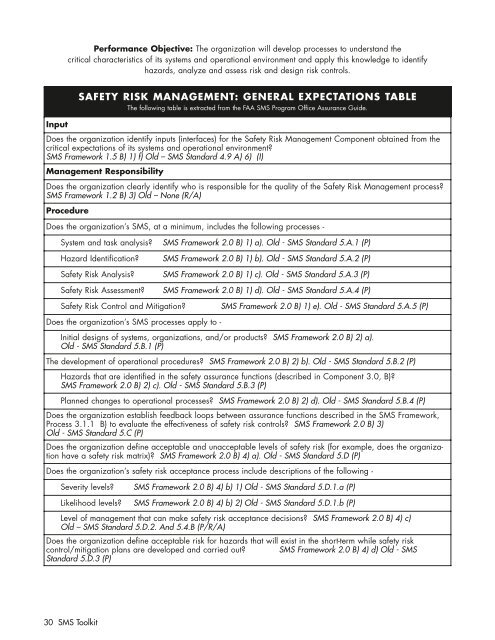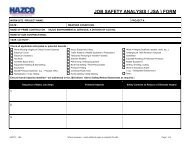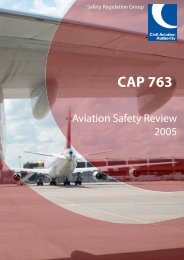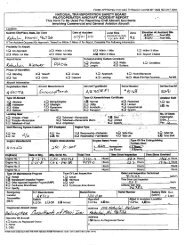International Helicopter Safety Team Safety Management System Toolkit
IHST - Safety Management Toolkit - Skybrary
IHST - Safety Management Toolkit - Skybrary
- No tags were found...
You also want an ePaper? Increase the reach of your titles
YUMPU automatically turns print PDFs into web optimized ePapers that Google loves.
Performance Objective: The organization will develop processes to understand the<br />
critical characteristics of its systems and operational environment and apply this knowledge to identify<br />
hazards, analyze and assess risk and design risk controls.<br />
SAFETY RISK MANAGEMENT: GENERAL EXPECTATIONS TABLE<br />
The following table is extracted from the FAA SMS Program Office Assurance Guide.<br />
Input<br />
Does the organization identify inputs (interfaces) for the <strong>Safety</strong> Risk <strong>Management</strong> Component obtained from the<br />
critical expectations of its systems and operational environment?<br />
SMS Framework 1.5 B) 1) f) Old – SMS Standard 4.9 A) 6) (I)<br />
<strong>Management</strong> Responsibility<br />
Does the organization clearly identify who is responsible for the quality of the <strong>Safety</strong> Risk <strong>Management</strong> process?<br />
SMS Framework 1.2 B) 3) Old – None (R/A)<br />
Procedure<br />
Does the organization’s SMS, at a minimum, includes the following processes -<br />
<strong>System</strong> and task analysis?<br />
Hazard Identification?<br />
<strong>Safety</strong> Risk Analysis?<br />
<strong>Safety</strong> Risk Assessment?<br />
SMS Framework 2.0 B) 1) a). Old - SMS Standard 5.A.1 (P)<br />
SMS Framework 2.0 B) 1) b). Old - SMS Standard 5.A.2 (P)<br />
SMS Framework 2.0 B) 1) c). Old - SMS Standard 5.A.3 (P)<br />
SMS Framework 2.0 B) 1) d). Old - SMS Standard 5.A.4 (P)<br />
<strong>Safety</strong> Risk Control and Mitigation?<br />
SMS Framework 2.0 B) 1) e). Old - SMS Standard 5.A.5 (P)<br />
Does the organization’s SMS processes apply to -<br />
Initial designs of systems, organizations, and/or products? SMS Framework 2.0 B) 2) a).<br />
Old - SMS Standard 5.B.1 (P)<br />
The development of operational procedures? SMS Framework 2.0 B) 2) b). Old - SMS Standard 5.B.2 (P)<br />
Hazards that are identified in the safety assurance functions (described in Component 3.0, B)?<br />
SMS Framework 2.0 B) 2) c). Old - SMS Standard 5.B.3 (P)<br />
Planned changes to operational processes? SMS Framework 2.0 B) 2) d). Old - SMS Standard 5.B.4 (P)<br />
Does the organization establish feedback loops between assurance functions described in the SMS Framework,<br />
Process 3.1.1 B) to evaluate the effectiveness of safety risk controls? SMS Framework 2.0 B) 3)<br />
Old - SMS Standard 5.C (P)<br />
Does the organization define acceptable and unacceptable levels of safety risk (for example, does the organization<br />
have a safety risk matrix)? SMS Framework 2.0 B) 4) a). Old - SMS Standard 5.D (P)<br />
Does the organization’s safety risk acceptance process include descriptions of the following -<br />
Severity levels?<br />
SMS Framework 2.0 B) 4) b) 1) Old - SMS Standard 5.D.1.a (P)<br />
Likelihood levels?<br />
SMS Framework 2.0 B) 4) b) 2) Old - SMS Standard 5.D.1.b (P)<br />
Level of management that can make safety risk acceptance decisions? SMS Framework 2.0 B) 4) c)<br />
Old – SMS Standard 5.D.2. And 5.4.B (P/R/A)<br />
Does the organization define acceptable risk for hazards that will exist in the short-term while safety risk<br />
control/mitigation plans are developed and carried out? SMS Framework 2.0 B) 4) d) Old - SMS<br />
Standard 5.D.3 (P)<br />
30 SMS <strong>Toolkit</strong>







